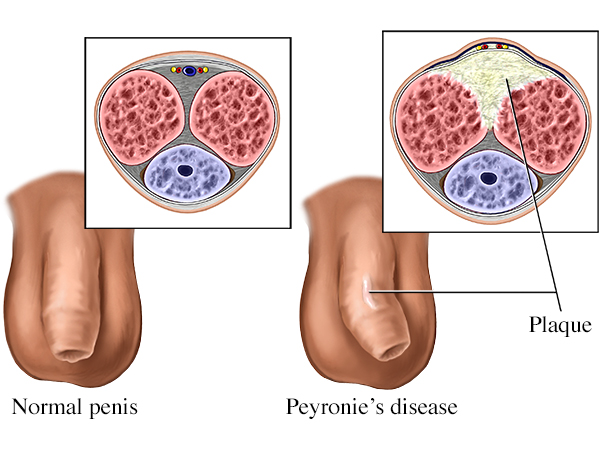Peyronie’s Disease
Peyronie’s disease is a common problem (approximately 5%) seen mostly in middle-aged men, and often has as much of a psychological impact than a physical one. It represents a scarring of the lining of the two erectile bodies of the penis, known as the corpora cavernosa, the lining being called the tunica albuginea. Although at times a patient can recall an injury to the penis preceding the problem, usually during sexual activity, the most common presentation is that it forms spontaneously in men that are starting to have less firm yet still useful erections. It is theorized that small tears occur in the tunica albuginea during sex that the body heals by laying down scar. At times, this scarring can be part of a more global syndrome, and is seen in patients that have scarring of the tendons in their hands called DePuytren’s contractures.
Symptoms of Peyronie’s Disease

A patient with Peyronie’s disease will first notice pain in the penis during erections that is described as a soreness that can at times be considerable. This is the inflammatory response that ultimately, usually within a few weeks or months of the pain starting, produces a scar that can be palpated in the flaccid penis. This scar is called a Peyronie’s plaque. As seen in the schematic shown, most plaques are located at the top of the penis. Approximately 20% will eventually become calcified.
The hallmark of Peyronie’s disease is penile deformity. This is most commonly seen as curvature of the erect penis produced as a result of the plaque not allowing expansion of the tunica albuginea at its location. However, this fixation of the tunica can also cause a waisting of the penis where it is constricted, shortening of the penis, or an unstable area of the penis while erect that causes it to hinge at that spot. The deformity is dictated by the shape and location of the plaque, and as the plaque develops the manifestation of the deformity can change as well. Peyronie’s disease rarely causes erectile dysfunction on its own unless severe, but can amplify any degree of erectile dysfunction a man already has.
Prognosis of Peyronie’s Disease
The vast majority of patients simply need to be reassured that the plaque is not a tumor and will not effect their lives negatively. In almost all cases, pain resolves with time alone, and any curvature or deformity that exists does not progress to the point that it makes sex difficult.
Once noticed, many patients seek advice from an Urologist. The vast majority of patients simply need to be reassured that the plaque is not a tumor and will not effect their lives negatively. In almost all cases, pain resolves with time alone, and any curvature or deformity that exists does not progress to the point that it makes sex difficult. It is the change to a man’s penis, and the resulting fear that it will progress in severity that makes the largest negative impact. Of all cases at presentation, approximately 20% will actually remodel and improve on their own, 40% remain stable and 40% worsen. But, even of those men that worsen the minority will progress to the point where they must seek treatment for Peyronie’s Disease to be able to have fulfilling sexual activity.
Medications & Supplements To Treat Peyronie’s Disease
It is this anxiety, and not necessarily physical deformity, that tends to drive men to seek non-surgical treatment. Unfortunately, there are very little data to support the use of oral remedies for Peyronie’s disease, but many men find the concept of simply accepting a minor curvature of the penis and not seeking some form of prospective therapy unacceptable. A partial list of such remedies would include Potaba, colchicine, Vitamin E, marketed herbal remedies, Coenzyme Q, and most recently Pentoxyfylline and L-Arginine. Dr. Engel does not discourage a man from trying these remedies as long as they are not overly expensive (Potaba) or cause side effects (colchicine). Pentoxyfylline, an old anti-hypertensive named Trental, has the most recent literature with some data supporting its use. Vitamin E is the simplest thing for a man to try. But in reality, Dr. Engel believes that it is time and one’s own body that will determine if the plaque will worsen, remodel, stabilize or calcify.
Next Steps
The approach that Dr. Engel takes is to have the patient decide if their degree of deformity is actually getting in the way of sexual activity. A distinction is made between this physical problem, and a situation where a man is suffering from the anxiety that can surround not knowing the future, or a struggle with one’s body image in that although one’s penis is fully functional it is the change that is causing anxiety. Dr. Engel also makes sure a patient is not simply seeking to improve erections. Here, getting a better erection is addressed, and not the Peyronie’s disease.




